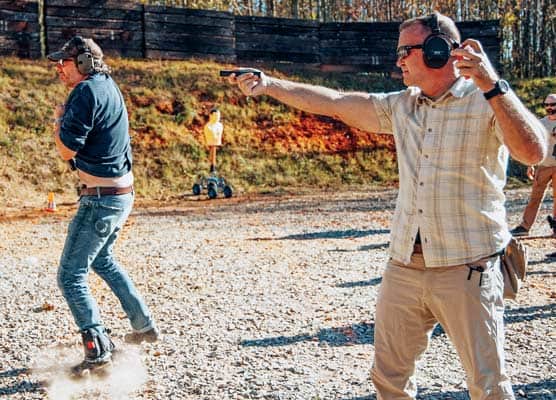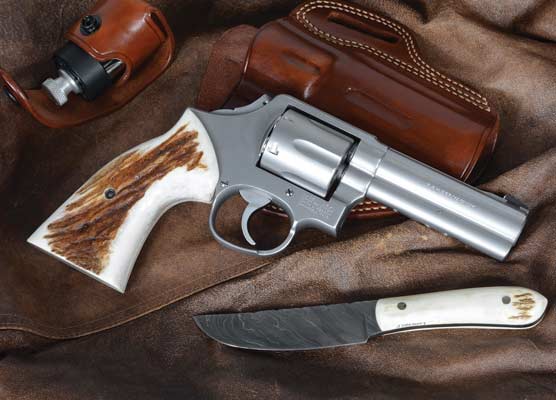The Right (And Wrong) Grips

S&W J-Frame Chiefs Specials. Model 36 nickel finish
with original-style grips, with a huge ditch behind the
trigger guard. Model 36 (above), and model 60 (right),
have Secret Service style grips by Eagle Grips. Model 36
nickel finish with original-style grips, with a huge ditch
behind the trigger guard
The human hand is a marvelous device, an instrument of both great force and the utmost delicacy. The hand can be balled into a fist to punch you in the mouth, or it can be used with delicacy and precision by a dental surgeon to repair the damage. The hand is also amazingly adaptable. My hands are about average in size; I feel most comfortable with S&W K-Frame revolvers or single-stack 1911s. But I can manage well enough with bigger or smaller revolvers and with semiauto pistols from little pocket automatics to the big Desert Eagle .50.
Those with unusually small or large hands may benefit from handgun grips made to suit them. The late Jeff Cooper said the word “grip” refers to how you hold the gun, while the firearm components we hold on to are called “stocks.” Incidentally, even those who make the products don’t always agree. Eagle Grips calls them, well, grips, while Herrett’s Stocks insists they are stocks. I use both terms interchangeably; I guess I am an unprincipled fence-sitter.
Why Custom?
One reason for custom grips is unusually small or large hands, though even then, it might not be enough. No grip change is going to make a small hand fit a Desert Eagle or make a tiny .25 ACP suitable for really large hands. A second reason is to compensate for an inherent flaw in the firearm design. I love collecting and shooting Colt and S&W double-action revolvers, but the early grip frames were just wrong, with a huge ditch behind the trigger guard. With a high enough grasp, so the weight of the frame rests on the second finger, the trigger finger can hardly bend enough to operate the trigger.
Whoever designed those grip frames for Colt and S&W must have had some seriously strange hands. It baffles me that Colt black powder single actions from a half-century earlier actually had more comfortable and more useable grip frames.
K-Frames
In my modest S&W collection, I have several K-Frames with original Magna-style grips. These were polished along with the grip frame and numbered to the specific piece, so I hate to take them off and inevitably lose them. When I want to shoot one of my older K-Frames, I generally add a grip adapter. The original Tyler T-Grip was made of aluminum, while later Pachmayr production used a tough synthetic. These fill the gap behind the trigger guard and improve handling at a modest cost.
For K-Frame S&Ws, my favorite grip is the Miculek style, designed by revolver wizard Jerry Miculek and made by Hogue. Hogue makes other grip styles as well, all of superb quality. I know of no other K-Frame grip that feels as good in the hand or handles and shoots as well. Jerry said he likes the grips to be smooth so he can “squirm the gun” if his initial grasp on the gun during a draw isn’t perfect. Once he tightens his grip on the gun, it doesn’t move any further. Smooth, not slippery, is how he describes the grip.
Different Carry
With J-Frame personal defensive revolvers, I prefer a grip style extending no further than the grip frame for easier pocket carry and made of smooth wood so as not to drag on clothing. Years ago, I began using the Secret Service style from Eagle Grips and to this day have found nothing I like better. They are made from various woods and polymers to enhance appearance as well as handling.
S&W also offered what they called Target-style grips, with additional wood filling the gap behind the trigger guard and extending beyond the bottom of the grip frame. I have such grips on my model 51 “Kit Gun” in .22 WMRF. Since I carry Kit Guns in a day pack or chest pouch, concealment and size are less of an issue. I also like Target grips on K-Frames, and my hands are just big enough to manage N-Frame Target grips
Cosmetics
A third reason for custom grips is to enhance appearance and pride of ownership. Wanting your personal firearm to be unique and striking in appearance is a perfectly normal desire. Maybe we can’t afford to have our handguns engraved and inlaid with gold, but we can add handsome grips at moderate cost and usually with no more tools than a screwdriver. Many semiauto pistols have easily replaceable grip panels. The Herrett’s Stocks web page shows a number of examples of the types of wood and checkering patterns available. Many are for 1911 styles, but there are also custom designs for the Beretta 92, Browning Hi-Power, Ruger and S&W .22s, the Walther PPK/S, as well as Colt and S&W revolvers.
For more info: Miculek.com, HogueInc.com, AltamontCo.com, EagleGrips.com, HerettStocks.com







